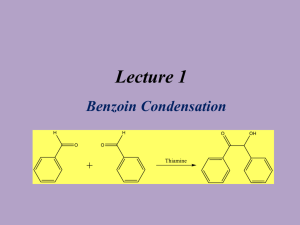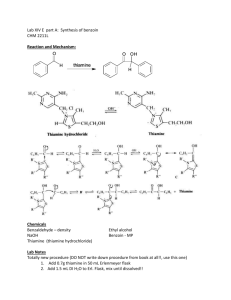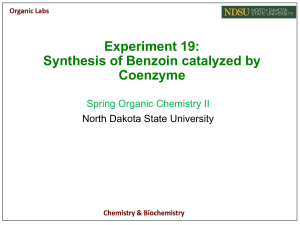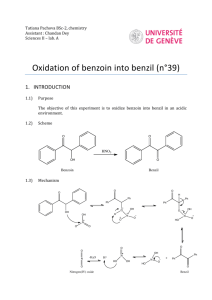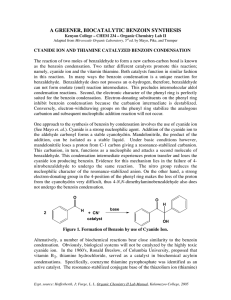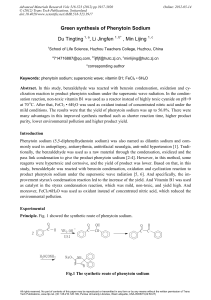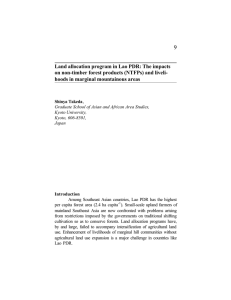Chem 30BL–Lecture 1_..
advertisement
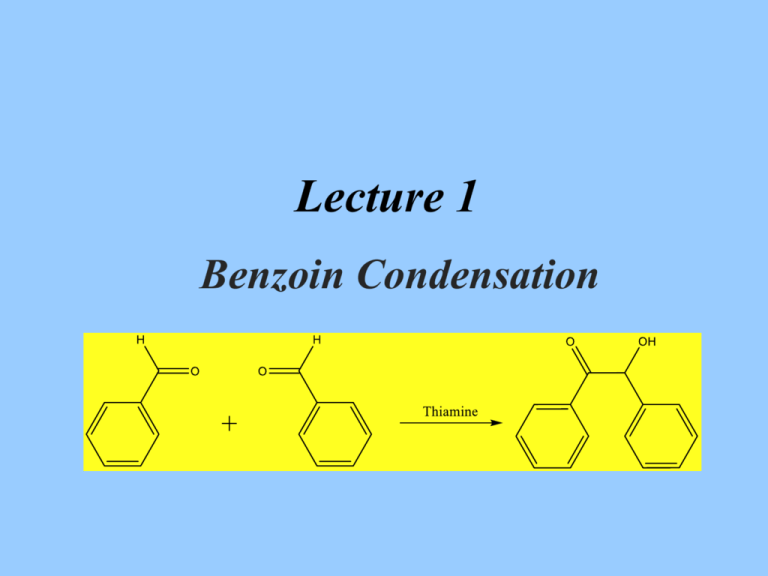
Lecture 1
Benzoin Condensation
Introduction
• Enzymes catalyze organic reaction in biological systems
• The high stereo-, regio- and chemoselectivity of the reactions can be
rationalized by the lock-and-key model
• Enzymes can be classified into six classes depending on the type of reaction
being catalyzed: hydrolases, isomerases, ligases, lyases, oxidoreductases and
transferases
• Often a coenzyme, which is a small organic molecule (i.e., many vitamins),
or a cofactor like metal ions (i.e., zinc, magnesium, iron, manganese, copper,
selenium) are required as well for the enzyme to function properly
• The reaction conditions like the temperature, the pH-value, the salinity,
the substrate, etc. are very important in these reactions
Benzoin Condensation using Cyanide
•
The reaction can be carried out by using cyanide ions as catalyst
•
The cyanide ion nucleophilically attacks the carbonyl group leading to an Umpolung
of the carbonyl group.
The reaction is much faster than the coenzyme catalyzed reaction (30 min vs. 72 h),
but it requires a better hood and a much more experienced experimenter
Problems
•
•
•
•
•
•
The possible formation of hydrogen cyanide (HCN) if the pH-value was not properly
controlled (pKa= 9.2) during the reaction or workup
Hydrogen cyanide has a low boiling point (25 oC)
It is highly toxic (LD50~500 mg/m3 for 1 minute inhalation, doses over 3000 mg/m3
are immediately fatal).
About 10-20 % of humans cannot smell the compound (bitter almond) due to a genetic trait
Benzoin Condensation using Thiamine
• Thiamine consists of a pyrimidine (two nitrogen atoms in benzene
ring) and a thiazole ring (nitrogen and sulfur atom in five-membered
ring)
• The lab uses the hydrochloride, which is ionic and dissolves well in
water (~100 g/100 mL), but poorly in 95 % ethanol (~1 g/100 mL).
• The highlighted proton (H) is removed from the
⁄
hydrochloride by the hydroxide ion (pKa=4.8).
This hydrogen is much more acidic because of the
adjacent nitrogen atom that bears a positive charge
(without the positive charge it would be pKa= ~30).
• Thiamine itself is
and not very stable in its free form
(heat, UV and base sensitive)
Green Chemistry Aspects
• The thiamine-based benzoin condensation is
“greener” in many ways
• Safer chemicals are used which reduces the
dangers in cases of accidents: no cyanide
• Dangerous waste prevention: no cyanide
• Higher energy efficiency: no reflux required
Benzoin Condensation - Mechanism
Breslow intermediate
Experimental I
• Dissolve the thiamine hydrochloride in water in a large vial
• Add 95 % ethanol
• Why is 95 % ethanol added?
To lower the polarity of the solution
• Add 2 N sodium hydroxide
solution
• Add benzaldehyde and mix well
• Which observation you make?
• What are you looking for here?
Homogeneous mixture
• Close and label the vial and store • Why is this necessary?
it in the drawer
To reduce the oxidation of
• Come back to the lab after
benzaldehyde to benzoic acid
2-3 days to check if crystals did • What can be done if
form
no crystals formed?
Scratching with a glass rod
on the inside of the flask
Experimental II
•
•
Place the vial with crystals in an ice-bath (=plenty
of water with some ice cubes for additional cooling)
Isolate the solids using vacuum filtration (view the
corresponding video on the course website and take
the online quiz!)
•
•
•
•
•
Do not forget to place the neoprene adapter between
the filter flask and the Hirsch funnel
The filter paper used for the Hirsch funnel is about
½ inch in diameter (Do not waste them!)
Wash the crystals with a small portions of ice-cold
water and ice-cold 95 % ethanol (1-2 mL as needed
to obtain a white solid!)
After sucking air through the crystals, place them on
a watch glass or in an open beaker to allow them to
dry until the next meeting
Characterization: yield, infrared spectrum (ATR,
review procedure in SKR and online) and melting
point are both acquired during meeting 3 after
drying the solid very thoroughly in an open beaker
Neoprene
adapter
Characterization I
• Melting point
• Infrared spectrum (ATR)
•
•
•
•
•
•
n(C=O)=1677 cm-1
n(OH)=3377, 3408 cm-1
n(CH, sp2)=3062, 3027 cm-1
n(CH, sp3)=2933 cm-1
nas(CCC)=1210 cm-1
13C{1H}-NMR
n(CH, sp3)
n(CH, sp2)
n(C=O)
n(OH)
nas(CCC)
(in CDCl3)
• d=192 ppm (C=O)
• d=127-139 ppm (arom. carbon)
• d=76 ppm (C-OH)
C-OH
C=O
Characterization II
• X-Ray Structure
• The structure of the unsubstituted benzoin does not display any
intramolecular hydrogen bonds but intermolecular hydrogen bonds
with the carbonyl group (~207 pm) and the oxygen atom of the alcohol
function (~217 pm) of the same neighboring benzoin molecules
(dotted lines)
